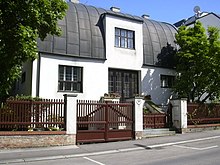Steiner House


48°11′02″N 16°16′59″E / 48.18389°N 16.28317°E Steiner House is a building in Vienna, Austria. It is considered one of the major works of architect Adolf Loos.
Background
Loos was still starting his career in 1910 when he designed and constructed the Steiner house in Vienna, Austria. This design was much better accepted than Loos' earlier works and quickly became a worldwide example of
The Steiner house features a living area that is raised slightly above the ground level and separated from more private areas of the house such as bedrooms and painting studio, which was located on the first floor.[Notes 1] The served space in this house is neatly separated from the serving space by placing the serving space in the basement and attic. This was the style for which Loos strove: a refined and intricate interior with a simple and nonthreatening exterior.[2]: 14
The Steiner house has a stucco façade like most of his other buildings but not without reason. Loos built his buildings with roughcast walls and used the stucco to form a protective skin over the bricks. Loos did not want to use the stucco as a cheap imitation rock and condemned that practice; in general he used stucco for its functionality. The stucco façades have another benefit: they create a smooth, unornamented, and white surface. This surface represents the nature of the material and also does not hint to what is inside the building.[1]: 66
Most of Loos' works were located in open lots and did not need any party walls and yet they faced other constraints that he had to work around. In the case of the Steiner house, Loos was only able build one floor above the street level.
Notes
References
- ^ a b c d
Tournikiotis, Panayotis (1994). Adolf Loos. New York: Princeton Architectural Press. ISBN 9781568983424.
- ^
Risselda, Max; Loos, Adolf (2008). RaumPlan Versus Plan Libre. Rotterdam: 010 Publishers. ISBN 9789064506659.
- ^
Sharp, Dennis (2002). Twentieth-century architecture: a visual history. Images Publishing. ISBN 9781864700855.
